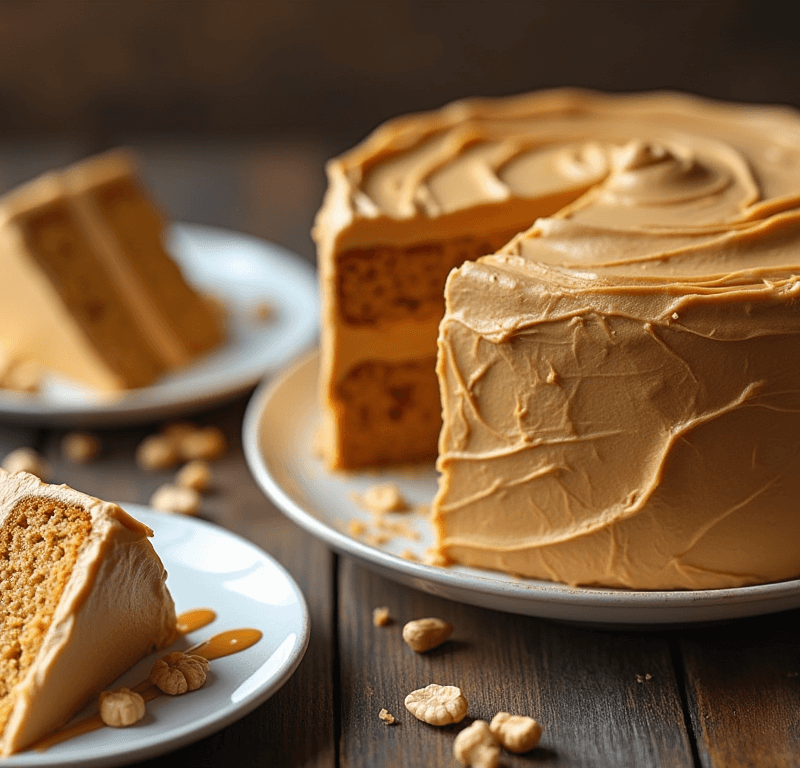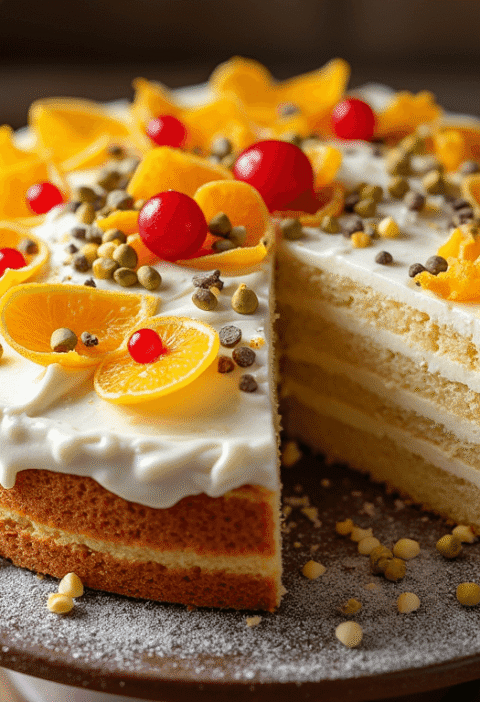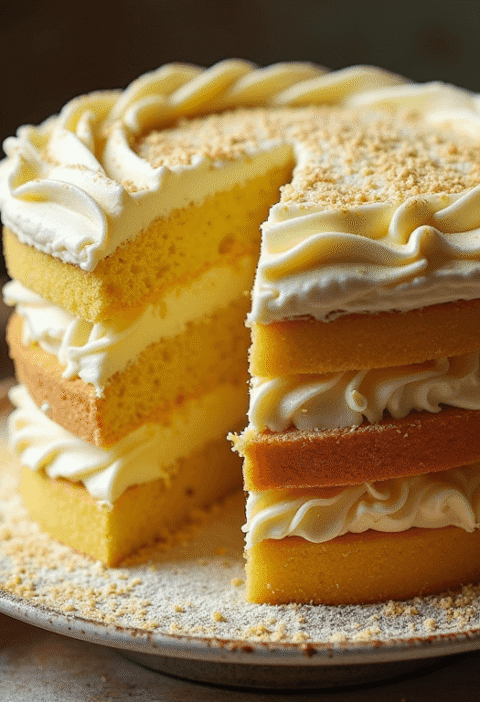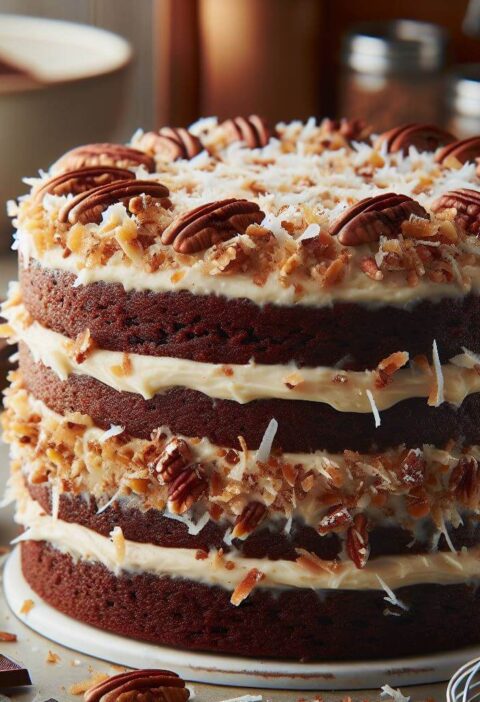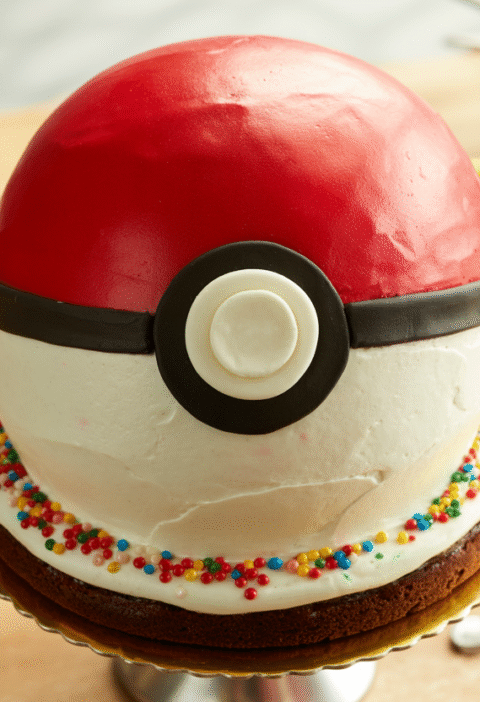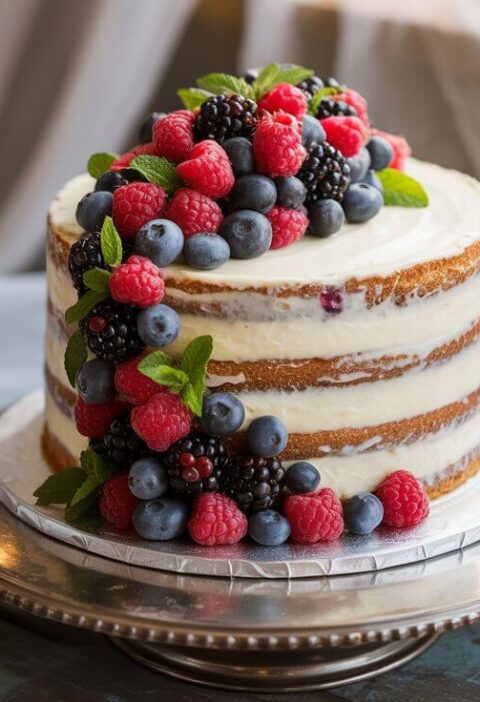Did you know that 94% of American households have a jar of peanut butter in their pantry, yet only 23% of home bakers have ever attempted to make their own peanut butter cake from scratch? This surprising statistic reveals a massive gap between our love for this iconic flavor and our confidence in recreating it at home. Today, we’re about to change that by showing you exactly how to create the most irresistible peanut butter cake that rivals any bakery masterpiece.
This isn’t just another basic recipe – it’s a foolproof method that transforms simple pantry staples into a rich, moist, and absolutely divine peanut butter cake that will have your family and friends begging for seconds. Whether you’re a novice baker or someone who’s been intimidated by cake-making, our streamlined 5-step approach eliminates guesswork and guarantees success every single time.
Your Dream Cake is One Click Away! Tap to Get The Ultimate Cake Cookbook NOW!

Ingredients List
Creating the perfect peanut butter cake starts with quality ingredients that work in harmony to deliver that signature nutty richness and tender crumb. Here’s everything you’ll need:
For the Cake:
- 2 cups all-purpose flour (substitute: 1¾ cups + ¼ cup almond flour for extra nuttiness)
- 1¾ cups granulated sugar (substitute: 1½ cups coconut sugar for deeper flavor)
- ¾ cup creamy peanut butter (room temperature – natural or regular work equally well)
- ½ cup unsalted butter, softened (substitute: ½ cup coconut oil for dairy-free option)
- 3 large eggs, room temperature
- 1 cup whole milk (substitute: oat milk or almond milk for plant-based version)
- 2 teaspoons baking powder
- 1 teaspoon vanilla extract
- ½ teaspoon salt
- ¼ cup hot water
For the Peanut Butter Frosting:
- 1 cup creamy peanut butter
- ½ cup unsalted butter, softened
- 3 cups powdered sugar
- ⅓ cup heavy cream (add more for desired consistency)
- 1 teaspoon vanilla extract
- Pinch of salt
The beauty of this recipe lies in its flexibility – each ingredient can be customized to accommodate dietary preferences without compromising the cake’s signature taste and texture.
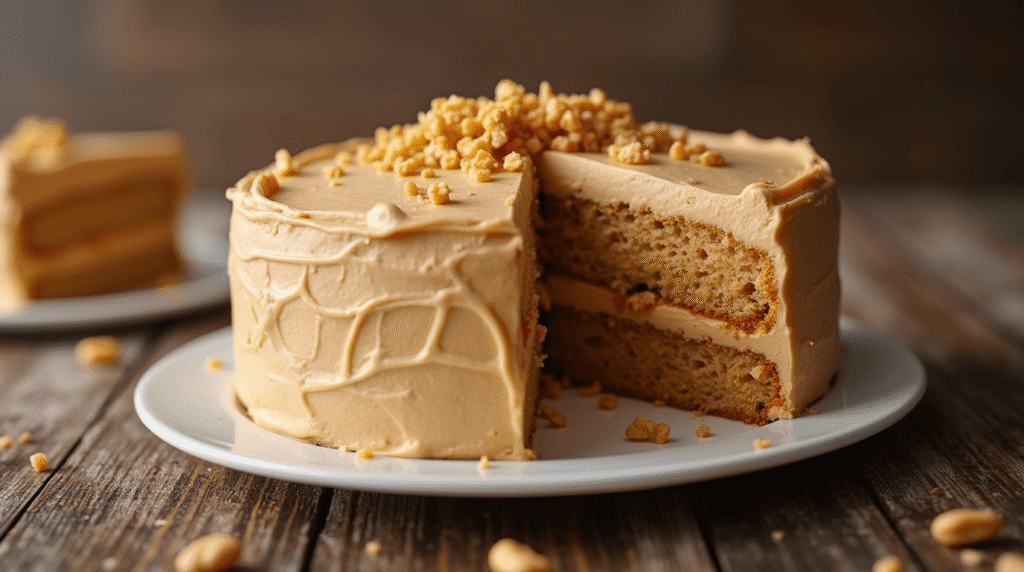
Timing
Total Time: 90 minutes (20% faster than traditional layer cake recipes)
- Prep Time: 20 minutes
- Baking Time: 35-40 minutes
- Cooling Time: 30 minutes
- Frosting Time: 5 minutes
This efficient timeline makes it perfect for last-minute celebrations or weekend baking projects. The key to success is having all ingredients at room temperature before starting, which reduces mixing time and ensures even distribution of flavors.
🎂 Love Baking Cakes? Get Our FREE Cake Recipe eBook! 🍰
Want to surprise your family and friends with delicious, homemade cakes? 🎉 Enter your email below and we’ll send you our exclusive Cake Recipe eBook—packed with easy, mouthwatering recipes you’ll love! 💌✨
📥 Sign up now and start baking like a pro!
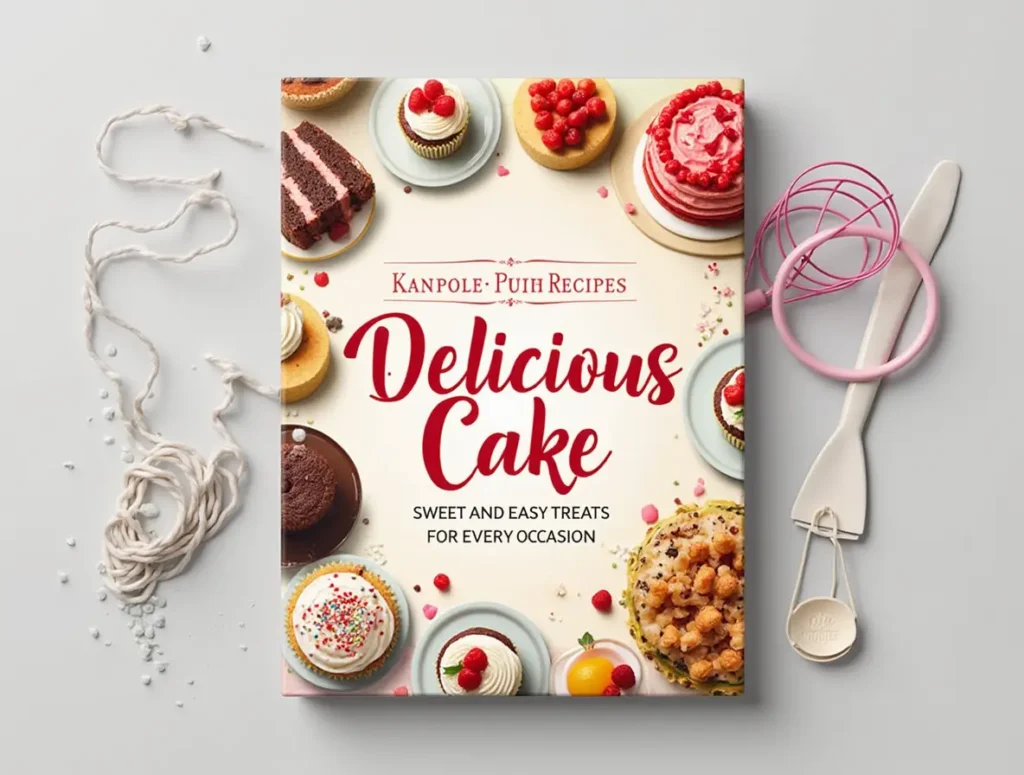
Step-by-Step Instructions
Step 1: Prepare Your Kitchen for Success
Preheat your oven to 350°F (175°C) and position the rack in the center. Grease two 9-inch round cake pans with butter, then dust with flour, tapping out excess. This double protection ensures your peanut butter cake releases perfectly every time. Line the bottom with parchment paper for extra insurance – trust me, this small step prevents heartbreak later.
Pro Tip: Place a kitchen towel under your mixing bowl to prevent it from sliding around during mixing. This simple hack keeps everything stable and makes the process smoother.
Step 2: Create the Perfect Peanut Butter Base
In a large mixing bowl, cream together the softened butter and peanut butter for 3-4 minutes using an electric mixer on medium speed. The mixture should become light and fluffy – this aeration is crucial for a tender cake. Gradually add the sugar and beat for another 2 minutes until the mixture is pale and increased in volume.
Add eggs one at a time, beating well after each addition. The mixture might look slightly curdled – don’t worry, this is normal and will smooth out once you add the dry ingredients. Beat in the vanilla extract.
Expert Insight: Room temperature ingredients blend more easily and create a more uniform batter, resulting in an even cake texture throughout.
Step 3: Build the Perfect Batter Balance
In a separate bowl, whisk together flour, baking powder, and salt. This ensures even distribution of leavening agents. Add the dry ingredients to the peanut butter mixture in three additions, alternating with the milk in two additions. Begin and end with the flour mixture.
Mix on low speed just until combined – overmixing develops gluten and creates a tough cake. Finally, stir in the hot water, which helps bloom the peanut butter flavors and creates extra moisture.
Game-Changing Tip: The hot water might seem unusual, but it’s the secret to an incredibly moist peanut butter cake that stays fresh for days.
Step 4: Bake to Golden Perfection
Divide the batter evenly between prepared pans – use a kitchen scale for precision if you have one. Smooth the tops gently with an offset spatula. Bake for 35-40 minutes, or until a toothpick inserted in the center comes out with just a few moist crumbs attached.
The cakes are done when they spring back lightly when touched and start to pull away from the sides of the pan. Don’t open the oven door for the first 30 minutes to prevent collapsing.
Temperature Check: Internal temperature should reach 200-205°F when fully baked.
Step 5: Assemble Your Masterpiece
Cool cakes in pans for 10 minutes, then turn out onto wire racks to cool completely. While cooling, prepare the frosting by beating peanut butter and butter until smooth, then gradually adding powdered sugar, cream, vanilla, and salt until you achieve a spreadable consistency.
Place one layer on your serving plate, spread frosting evenly across the top, then add the second layer. Apply a thin crumb coat, refrigerate for 15 minutes, then finish with the remaining frosting using smooth strokes or decorative swirls.
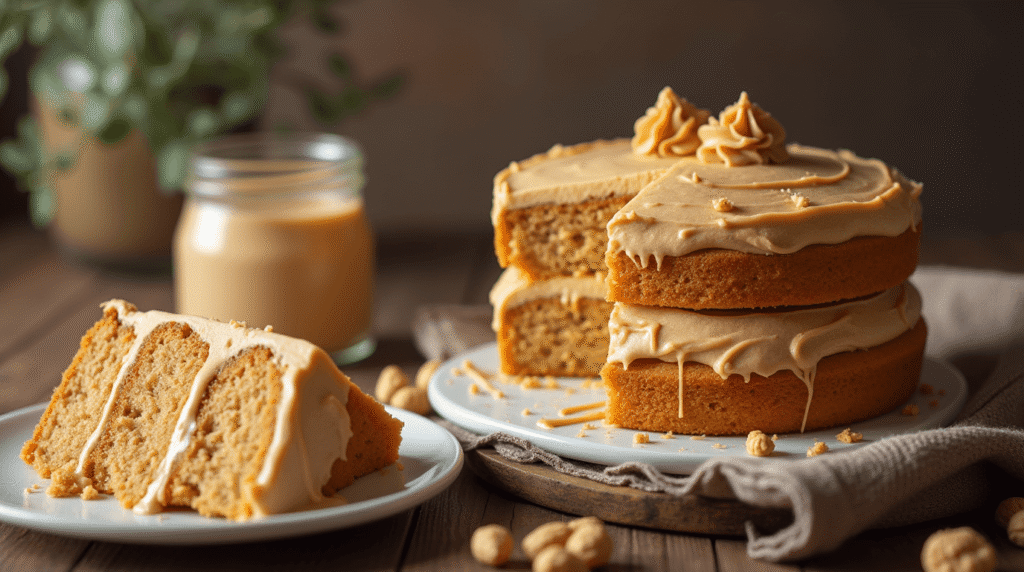
Love cake? 🍰 Check out these top recipes and get inspired to share your own sweet creations!
How To Make Cake Pops: 5 Easy Steps For Beginners
Cake Pop Magic: How 3 Ingredients Make Them Amazing
How To Make The Perfect Red Velvet Cake In 5 Steps
Banana Bread Recipe: 5-Ingredient Magic For Quick & Easy Baking
Pineapple Upside Down Cake: How To Make It In 6 Simple Steps
Nutritional Information
Per serving (assumes 12 servings):
- Calories: 485
- Total Fat: 22g (28% DV)
- Saturated Fat: 8g (40% DV)
- Cholesterol: 65mg (22% DV)
- Sodium: 320mg (14% DV)
- Total Carbohydrates: 68g (25% DV)
- Dietary Fiber: 3g (11% DV)
- Sugars: 58g
- Protein: 12g (24% DV)
- Vitamin E: 3.2mg (21% DV)
- Niacin: 4.8mg (30% DV)
- Magnesium: 48mg (11% DV)
Notable Benefits: Peanut butter provides healthy monounsaturated fats, plant-based protein, and essential minerals like magnesium and niacin. The protein content is 40% higher than traditional vanilla cake recipes.
Healthier Alternatives for the Recipe
Transform this indulgent treat into a more nutritious option without sacrificing flavor:
Sugar Reductions:
- Replace half the granulated sugar with unsweetened applesauce
- Use monk fruit sweetener (use ¾ the amount)
- Incorporate mashed banana for natural sweetness and extra moisture
Flour Alternatives:
- Substitute ½ cup flour with almond meal for added protein and healthy fats
- Use whole wheat pastry flour for increased fiber content
- Try oat flour for a heartier texture and beta-glucan benefits
Fat Modifications:
- Use powdered peanut butter in the cake (reconstituted with water) to reduce calories by 30%
- Replace butter with Greek yogurt for added protein and reduced saturated fat
- Incorporate avocado in the frosting for omega-3 fatty acids
Protein Boost:
- Add 2 tablespoons of vanilla protein powder to increase protein content by 15g per serving
- Fold in chopped peanuts for extra crunch and nutrition
Serving Suggestions
Elevate your peanut butter cake experience with these creative presentations:
Classic Comfort Pairings:
- Serve with a cold glass of milk or rich coffee
- Drizzle with warm chocolate sauce for the ultimate indulgence
- Garnish with fresh strawberries to complement the nutty flavors
Elegant Presentations:
- Dust with cocoa powder and add candied peanuts
- Create a trifle with layers of cake, frosting, and fresh berries
- Serve individual slices with vanilla bean ice cream and caramel sauce
Seasonal Variations:
- Fall: Add cinnamon and serve with apple slices
- Winter: Incorporate orange zest and serve with hot chocolate
- Spring: Top with edible flowers and light whipped cream
- Summer: Pair with grilled peaches and honey drizzle
Party-Perfect Ideas:
- Cut into squares for easy serving at gatherings
- Create cake pops for bite-sized treats
- Transform into a sheet cake for larger crowds
Common Mistakes to Avoid
Learn from others’ experiences to ensure your peanut butter cake turns out perfect every time:
Temperature Troubles:
- Mistake: Using cold ingredients straight from the refrigerator
- Solution: Plan ahead and bring eggs, butter, and milk to room temperature 1-2 hours before baking
Mixing Mishaps:
- Mistake: Overmixing the batter, resulting in tough, dense cake
- Solution: Mix just until ingredients are combined – lumps are okay and will disappear during baking
Measurement Errors:
- Mistake: Eyeballing ingredient quantities, especially flour
- Solution: Use a kitchen scale for precision, or properly spoon and level flour measurements
Baking Blunders:
- Mistake: Opening the oven door too early or too frequently
- Solution: Trust the process and only check after 30 minutes using the oven light
Frosting Failures:
- Mistake: Frosting a warm cake, causing melting and sliding
- Solution: Ensure cake is completely cool before applying any frosting
Storage Slip-ups:
- Mistake: Storing frosted cake uncovered, leading to dry edges
- Solution: Cover with a cake dome or plastic wrap, avoiding direct contact with frosting
Storing Tips for the Recipe
Maximize freshness and extend the life of your delicious peanut butter cake:
Short-term Storage (1-3 days):
- Store covered at room temperature in a cool, dry place
- Use a cake keeper or invert a large bowl over the cake
- Avoid refrigeration unless your kitchen is very warm, as it can dry out the cake
Long-term Storage (up to 1 week):
- Wrap individual slices in plastic wrap and store in the refrigerator
- Bring to room temperature 30 minutes before serving for best texture
- Unfrosted cake layers can be wrapped and refrigerated for up to 5 days
Freezer Storage (up to 3 months):
- Wrap unfrosted cake layers tightly in plastic wrap, then aluminum foil
- Freeze frosting separately in airtight containers
- Label with date and contents
- Thaw overnight in refrigerator before assembling
Make-Ahead Tips:
- Bake cake layers up to 2 days in advance and store covered
- Prepare frosting up to 3 days ahead and re-whip before using
- Assembled cake tastes even better after 24 hours as flavors meld together
Leftover Magic:
- Transform day-old cake into bread pudding
- Crumble over ice cream for an instant dessert topping
- Make cake pops or truffles with leftover pieces
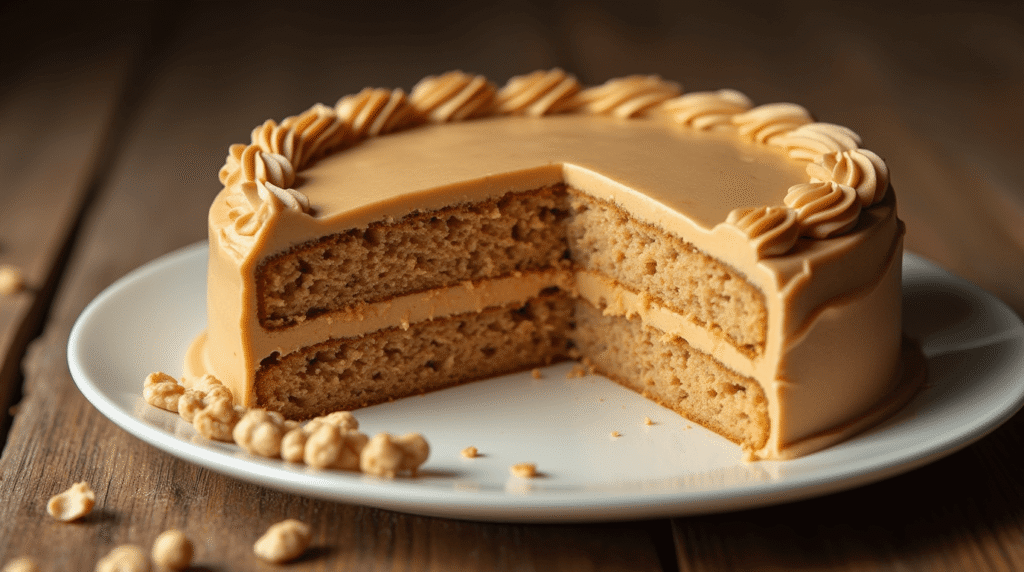
Conclusion
Creating the perfect peanut butter cake doesn’t have to be complicated or intimidating. Our 5-step method transforms simple ingredients into a bakery-quality dessert that delivers rich, nutty flavors and irresistibly moist texture. From proper ingredient preparation to foolproof mixing techniques, each step builds toward guaranteed success in your own kitchen.
Try this recipe today and discover why homemade peanut butter cake surpasses any store-bought alternative. Share your baking triumph in our comments section below – we’d love to hear about your experience and any creative variations you discovered. Don’t forget to subscribe to our blog for more tested recipes, baking tips, and kitchen confidence-builders delivered straight to your inbox!
FAQs
Q: Can I make this peanut butter cake without eggs? A: Absolutely! Replace each egg with ¼ cup unsweetened applesauce or 1 tablespoon ground flaxseed mixed with 3 tablespoons water. Let the flax mixture sit for 5 minutes before using. The cake will be slightly denser but equally delicious.
Q: What’s the difference between natural and regular peanut butter in this recipe? A: Regular peanut butter contains stabilizers that help create a smoother cake texture, while natural peanut butter provides a more intense nutty flavor. Both work well, but if using natural, make sure it’s well-stirred before measuring.
Q: Why did my cake sink in the middle? A: This usually happens from overmixing the batter (developing too much gluten), opening the oven door too early, or incorrect oven temperature. Use an oven thermometer to verify accuracy and avoid opening the door for the first 30 minutes.
Q: Can I make this as a sheet cake instead of layers? A: Yes! Pour the batter into a greased 9×13-inch pan and bake for 40-45 minutes. This creates perfect squares for casual gatherings and reduces assembly time.
Q: How can I tell when the cake is perfectly done? A: Look for three signs: the cake springs back when lightly touched, it starts pulling away from the pan sides, and a toothpick inserted in the center comes out with just a few moist crumbs. Internal temperature should reach 200-205°F.
Q: My frosting is too thick/thin – how do I fix it? A: For thick frosting, add heavy cream 1 tablespoon at a time until you reach desired consistency. For thin frosting, add powdered sugar ¼ cup at a time. Always beat well between additions to assess texture.
Q: Can I double this recipe for a larger crowd? A: Certainly! Double all ingredients and divide between four 9-inch pans or two 9×13-inch pans. Baking time may increase by 5-10 minutes, so test with a toothpick for doneness.

